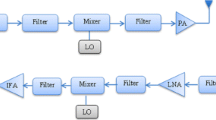Abstract
A wireless sensor network is a collection of tiny sensor nodes that are deployed to monitor a physical environment. These sensor nodes are generally powered by non-renewable batteries and maybe deployed in harsh environment. Thus, energy resource is precious that makes protocols design for this kind of networks a crucial challenge. Especially, in physical layer, orthogonal modulations as PPM or FSK are suitable. The commonly used models to investigate the network lifetime are based on a linear battery discharge. Really, the battery discharge is closely bonded to the discharge current, and typically is non-linear. This paper presents a performance analysis of both PPM and FSK modulations used in battery powered wireless sensor node. A Rakhmatov–Vrudhula–Wallach model is used to evaluate the used battery charge for a given instantaneous current load. By numerical results, it is proved that PPM modulation outperforms FSK one in term of battery charge use for different network density and for different M-ary signaling schemes.












Similar content being viewed by others
References
Nguyen, L. T., Defago, X., Beuran, R., & Shinoda, Y. (2008). An energy efficient routing scheme for mobile wireless sensor networks. In IEEE/ISWCS (pp. 568–572).
Yrjola, J. (2005). Summary of energy efficiency communication protocol for wireless micro sensor networks. In T-79.194 seminar on theoretical computer science. Helsinki University of Technology.
Chandrakasan, A., Amirtharajah, R., Cho, S., Goodman, J., Konduri, G., Rabiner, W., & Wang, A. (1999). Design considerations for distributed micro-sensor systems. In Proceedings of the IEEE 1999 custom integrated circuits conference (CICC’99) (pp. 279–286). San Diego, CA, USA.
Estrin, D., Girod, L., Pottie, G., & Srivastava, M. (2001). Instrumenting the world with wireless sensor networks. In Proceedings of the IEEE international conference on acoustics, speech and signal processing (ICASSP 2001), vol. 4 (pp. 2033–2036). Salt Lake City, Utah, USA.
Estrin, D., Govindan, R., Heidemann, J., & Kumar, S. (1999). Next century challenges: Scalable coordination in sensor networks. In Proceedings of the 5th annual ACM/IEEE international conference on mobile computing and networking (MobiCom’99) (pp. 263–270). Seattle Washington, USA.
Martin, T. (1999). Balancing batteries, power, and performance: System issues in CPU speed-setting for mobile computing. Ph.D. Dissertation, August 1999.
Qu, F., Yang, L., & Swami, A. (2007). Battery power efficiency of PPM and OOK in wireless sensor networks. In Proceedings of the acoustics, speech and signal processing, 2007. ICASSP 2007 (pp. III-525–III-528).
Tang, Q., Yang, L., Giannakis, G. B., & Qin, T. (2007). Battery power efficiency of PPM and FSK in wireless sensor networks. IEEE Transactions on Wireless Communications, 6(4), 1308–1319.
Duan, D., Qu, F., Yang, L., Swami, A., & Principe, J. C. (2010). Modulation selection from a battery power efficiency perspective. IEEE Transactions on Communications, 58(7), 1907–1911.
Pedram, M., & Wu, Q. (2002). Battery-powered digital CMOS design. IEEE Transactions on Very Large Scale Integration (VLSI) Systems, 10(5), 601–607.
Jongerden, M. R., & Haverkort, B. R. (2009). Which battery model to use? IET Software, 3(6), 445–457.
Doyle, M., Fuller, T. F., & Newman, J. (1993). Modeling of galvano static charge and discharge of the lithium/polymer/insertion cell. Journal of the Electrochemical Society, 140(6), 1526–1533.
Fuller, T., Doyle, M., & Newman, J. (1994). Simulation and optimization of the dual lithium ion insertion cell. Journal of the Electrochemical Society, 141(1), 1–10.
Chen, M., & Rincon-Mora, G. A. (2006). Accurate electrical battery model capable of predicting runtime and I–V performance. IEEE Transactions on Energy Conversion, 21(2), 504–511.
Chiasserini, C., & Rao, R. (1999). Pulsed battery discharge in communication devices. In Proceedings of the 5th annual ACM/IEEE international conference on mobile computing and networking (pp. 88–95).
Rakhmatov, D., Vrudhula, S., & Chakrabarti, C. (2002). Battery- conscious task sequencing for portable devices including voltage/clock scaling. In Proceedings of the 39th annual design automation conference (DAC) (pp. 189–194). June 2002.
Zhang, Fumin, & Shi, Zhenwu (2009). Optimal and adaptive battery discharge strategies for cyber-physical systems. In Proceedings of the 48th IEEE conference on decision and control, 2009 held jointly with the 2009 28th Chinese control conference. CDC/CCC 2009 (pp. 6232–6237). 15–18 Dec. 2009.
Chau, Chi-Kin, Qin, Fei, Sayed, S., Wahab, M. H., & Yang, Yang. (2010). Harnessing battery recovery effect in wireless sensor networks: Experiments and analysis. IEEE Journal on Selected Areas in Communications, 28(7), 1222–1232.
Rakhmatov, D., & Vrudhula, S. (2003). Energy management for battery-powered embedded systems. ACM Transactions on Embedded Computing Systems, 2(3), 277–324.
Rao, R., & Vrudhula, S. (2005). Battery optimization vs energy optimization: Which to choose and when?. In IEEE/ACM international conference on computer-aided design, 2005. ICCAD-2005 (pp. 439–445). 6–10 Nov 2005.
Zheng, N., Wu, Z., Lin, M., & Wang, Q. (2008). An iterative computation method for interpreting and extending an analytical battery model. Journal of Zhejiang University SCIENCE A., 9(2), 279–288.
Schwartz, J.D., Azaña, J., Zicha, N., & Plant, D.V. (2009). Design and analysis of a compact UWB pulse generator with programmable pulse shape. In IEEE international conference on ultra-wideband. ICUWB-2009 (pp. 38–42). Sep 2009.
Ye, W., Heidemann, J., & Estrin, D. (2004). Medium access control with coordinated adaptive sleeping for wireless sensor networks. IEEE/ACM Transactions on Networking, 12(3), 493–506.
Author information
Authors and Affiliations
Corresponding author
Rights and permissions
About this article
Cite this article
Zytoune, O., Aboutajdine, D. Energy usage analysis of digital modulations in wireless sensor networks with realistic battery model. Wireless Netw 22, 2713–2725 (2016). https://doi.org/10.1007/s11276-015-1115-9
Published:
Issue Date:
DOI: https://doi.org/10.1007/s11276-015-1115-9




